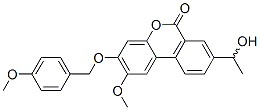All AbMole products are for research use only, cannot be used for human consumption.

Palomid 529 (P529) is a novel potent PI3K/Akt/mTOR inhibitor and shows a potent antiproliferative activity in the NCI-60 cell lines panel, with growth inhibitory 50 (GI50) <35 μM. Palomid 529 (P529), which inhibits the TORC1 and TORC2 complexes and shows both inhibition of Akt signaling and mTOR signaling similarly in tumor and vasculature. Palomid 529 (P529) inhibited both VEGF-driven (IC50 = 20 nM) and bFGF-driven (IC50 = 30 nM) endothelial cell proliferation and retained the ability to induce endothelial cell apoptosis.
| Cell Experiment | |
|---|---|
| Cell lines | HUVECs |
| Preparation method | Human umbilical vascular endothelial cell proliferation. The proliferation assay was carried out by seeding the HUVECs in 96-well plates at a density of 1,000 per well in complete medium. Following a 24-h plating period, the cells were starved for 24 h in 0.5% serum before being treated with P529 in the presence of 10 ng/mL basic fibroblast growth factor (bFGF) or VEGF in complete medium. After 48 h, cell number was determined using a colorimetric method as described by the supplier (Promega). The results were expressed as the percentage of the maximal bFGF or VEGF response in the absence of P529. Nonproliferating endothelial cells were assayed by growing HUVECs to quiescence in 96-well plates and treating with P529 for 48 h. Initially, 5,000 cells per well were seeded and confluence was achieved the next day. The plates were incubated for another 24 h to ensure growth arrest before treatment with P529. Cell number was determined as outlined above. |
| Concentrations | 0~10mM |
| Incubation time | 48 h |
| Animal Experiment | |
|---|---|
| Animal models | U87 glioma xenograft in Four- to 6-wk-old female nude mice |
| Formulation | saline |
| Dosages | 50 mg and 25mg/kg/2 d, for 1 wk |
| Administration | i.p. |
| Molecular Weight | 406.43 |
| Formula | C24H22O6 |
| CAS Number | 914913-88-5 |
| Solubility (25°C) | DMSO 60 mg/mL |
| Storage |
Powder -20°C 3 years ; 4°C 2 years In solvent -80°C 6 months ; -20°C 1 month |
| Related mTOR Products |
|---|
| RMC-4627
RMC-4627 is a selective mTORC1 inhibitor that activates 4EBP1 and inhibits tumor growth. |
| RMC-4529
RMC-4529 has an IC50 value of 1.0 nM against p-4E-BP1-(T37/46) in mTOR kinase cellular assay. |
| WYE-687 dihydrochloride
WYE-687 dihydrochloride is an ATP-competitive mTOR inhibitor with an IC50 of 7 nM. |
| Rapamycin-d3
Rapamycin-d3 |
| L-Leucine-d10
L-Leucine-d10 |
All AbMole products are for research use only, cannot be used for human consumption or veterinary use. We do not provide products or services to individuals. Please comply with the intended use and do not use AbMole products for any other purpose.


Products are for research use only. Not for human use. We do not sell to patients.
© Copyright 2010-2024 AbMole BioScience. All Rights Reserved.
